Recent Advances in RAFT Polymerization: Novel Initiation Mechanisms and Optoelectronic Applications
Abstract
:1. Introduction
2. General Mechanism of RAFT Process
3. Novel RAFT Techniques
3.1. Photo-Induced Initiation
3.2. Metal-Catalytic Initiation
3.3. Redox Initiation
3.4. Enzyme Initiation
3.5. Acid Initiation
3.6. Other Initiation
3.7. Sulfur-Free RAFT Polymerization
4. Application
5. Conclusions
Acknowledgments
Author Contributions
Conflicts of Interest
References
- Sugita, H.; Nojima, M.; Ohta, Y.; Yokozawa, T. Unusual cyclic polymerization through suzuki-miyaura coupling of polyphenylene bearing diboronate at both ends with excess dibromophenylene. Chem. Commun. 2017, 53, 396–399. [Google Scholar] [CrossRef] [PubMed]
- Raj, M.R.; Kim, M.; Kim, H.I.; Lee, G.-Y.; Park, C.W.; Park, T. A comparative study on the thermal- and microwave-assisted stille coupling polymerization of a benzodithiophene-based donor-acceptor polymer (PTB7). J. Mater. Chem. A 2017, 5, 3330–3335. [Google Scholar] [CrossRef]
- Abdul Kudus, M.H.; Zakaria, M.R.; Hafi Othman, M.B.; Md Akil, H. Preparation and characterization of colloidized diamine/oxidized-graphene via condensation polymerization of carboxyl groups epoxy/oxidized-graphene nanocomposite. Polymer 2017, 124, 186–202. [Google Scholar] [CrossRef]
- Nojima, M.; Ohta, Y.; Yokozawa, T. Investigation of catalyst-transfer condensation polymerization for synthesis of poly(p-phenylenevinylene). J. Polym. Sci. Part A 2014, 52, 2643–2653. [Google Scholar] [CrossRef]
- Yokozawa, T.; Yokoyama, A. Chain-growth condensation polymerization for the synthesis of well-defined condensation polymers and π-conjugated polymers. Chem. Rev. 2009, 109, 5595–5619. [Google Scholar] [CrossRef] [PubMed]
- Kamigaito, M.; Ando, T.; Sawamoto, M. Metal-catalyzed living radical polymerization. Chem. Rev. 2001, 101, 3689–3746. [Google Scholar] [CrossRef] [PubMed]
- Moad, G.; Solomon, D.H. The Chemistry of Radical Polymerization, 2nd ed.; Elsevier: Amsterdam, The Netherlands, 2006. [Google Scholar]
- Matyjaszewski, K.; Davis, T.P. Handbook of Radical Polymerization, 1st ed.; John Wiley & Sons: Hoboken, NJ, USA, 2003. [Google Scholar]
- Braunecker, W.A.; Matyjaszewski, K. Controlled/living radical polymerization: Features, developments, and perspectives. Prog. Polym. Sci. 2007, 32, 93–146. [Google Scholar] [CrossRef]
- Coessens, V.; Pintauer, T.; Matyjaszewski, K. Functional polymers by atom transfer radical polymerization. Prog. Polym. Sci. 2001, 26, 337–377. [Google Scholar] [CrossRef]
- Otsu, T.; Yoshida, M.; Tazaki, T. A model for living radical polymerization. Macromol. Chem. Rapid Commun. 1982, 3, 133–140. [Google Scholar] [CrossRef]
- Szwarc, M. ‘Living’ polymers. Nature 1956, 178, 1168–1169. [Google Scholar] [CrossRef]
- Crivello, J.V.; Lam, J.H.W. Diaryliodonium salts. A new class of photoinitiators for cationic polymerization. Macromolecules 1977, 10, 1307–1315. [Google Scholar] [CrossRef]
- Crivello, J.V. Cationic polymerization—Iodonium and sulfonium salt photoinitiators. In Initiators—Poly-Reactions—Optical Activity, 1st ed.; Springer: Berlin/Heidelberg, Germany, 1984; Volume 62, pp. 1–48. [Google Scholar]
- Young, R.N.; Quirk, R.P.; Fetters, L.J. Anionic polymerizations of non-polar monomers involving lithium. In Anionic Polymerization, 1st ed.; Springer: Berlin/Heidelberg, Germany, 1984; Volume 56, pp. 1–90. [Google Scholar]
- Hadjichristidis, N.; Pitsikalis, M.; Pispas, S.; Iatrou, H. Polymers with complex architecture by living anionic polymerization. Chem. Rev. 2001, 101, 3747–3792. [Google Scholar] [CrossRef] [PubMed]
- Bielawski, C.W.; Grubbs, R.H. Living ring-opening metathesis polymerization. Prog. Polym. Sci. 2007, 32, 1–29. [Google Scholar] [CrossRef]
- Xu, G.; Chung, T.C. Borane chain transfer agent in metallocene-mediated olefin polymerization. Synthesis of borane-terminated polyethylene and diblock copolymers containing polyethylene and polar polymer. J. Am. Chem. Soc. 1999, 121, 6763–6764. [Google Scholar] [CrossRef]
- Xu, G.; Chung, T.C. Synthesis of syndiotactic polystyrene (s-PS) containing a terminal polar group and diblock copolymers containing s-PS and polar polymers. Macromolecules 1999, 32, 8689–8692. [Google Scholar] [CrossRef]
- Nicolas, J.; Guillaneuf, Y.; Lefay, C.; Bertin, D.; Gigmes, D.; Charleux, B. Nitroxide-mediated polymerization. Prog. Polym. Sci. 2013, 38, 63–235. [Google Scholar] [CrossRef]
- Hawker, C.J.; Bosman, A.W.; Harth, E. New polymer synthesis by nitroxide mediated living radical polymerizations. Chem. Rev. 2001, 101, 3661–3688. [Google Scholar] [CrossRef] [PubMed]
- Matyjaszewski, K.; Xia, J. Atom transfer radical polymerization. Chem. Rev. 2001, 101, 2921–2990. [Google Scholar] [CrossRef] [PubMed]
- Chiefari, J.; Chong, Y.K.; Ercole, F.; Krstina, J.; Jeffery, J.; Le, T.P.T.; Mayadunne, R.T.A.; Meijs, G.F.; Moad, C.L.; Moad, G.; et al. Living free-radical polymerization by reversible addition-fragmentation chain transfer: The RAFT process. Macromolecules 1998, 31, 5559–5562. [Google Scholar] [CrossRef]
- Perrier, S.; Takolpuckdee, P. Macromolecular design via reversible addition-fragmentation chain transfer (RAFT)/xanthates (madix) polymerization. J. Polym. Sci. Part A 2005, 43, 5347–5393. [Google Scholar] [CrossRef]
- Nakatani, R.; Takano, H.; Chandra, A.; Yoshimura, Y.; Wang, L.; Suzuki, Y.; Tanaka, Y.; Maeda, R.; Kihara, N.; Minegishi, S.; et al. Perpendicular orientation control without interfacial treatment of RAFT-synthesized high-χ block copolymer thin films with sub-10 nm features prepared via thermal annealing. ACS Appl. Mater. Interfaces 2017, 9, 31266–31278. [Google Scholar] [CrossRef] [PubMed]
- Jiang, Z.-Q.; Zhao, S.-Q.; Su, Y.-X.; Liu, N.; Wu, Z.-Q. Combination of RAFT and Pd(II)-initiated isocyanide polymerizations: A versatile method for facile synthesis of helical poly(phenyl isocyanide) block and star copolymers. Macromolecules 2018, 51, 737–745. [Google Scholar] [CrossRef]
- Döhler, D.; Kaiser, J.; Binder, W.H. Supramolecular H-bonded three-arm star polymers by efficient combination of RAFT polymerization and thio-bromo “click” reaction. Polymer 2017, 122, 148–158. [Google Scholar] [CrossRef]
- Tochwin, A.; El-Betany, A.; Tai, H.; Chan, K.; Blackburn, C.; Wang, W. Thermoresponsive and reducible hyperbranched polymers synthesized by RAFT polymerisation. Polymers 2017, 9, 443. [Google Scholar] [CrossRef]
- Chen, L.; Li, Y.; Yue, S.; Ling, J.; Ni, X.; Shen, Z. Chemoselective RAFT polymerization of a trivinyl monomer derived from carbon dioxide and 1,3-butadiene: From linear to hyperbranched. Macromolecules 2017, 50, 9598–9606. [Google Scholar] [CrossRef]
- Sutrisno, J.; Pramudya, I.; Aerken, X.; Fuchs, A. Surface grafting of poly(pentafluorostyrene) on the iron and iron oxide particles via reversible addition fragmentation chain transfer (RAFT) polymerization. J. Appl. Polym. Sci. 2017, 134, 44898. [Google Scholar] [CrossRef]
- Kochameshki, M.G.; Marjani, A.; Mahmoudian, M.; Farhadi, K. Grafting of diallyldimethylammonium chloride on graphene oxide by RAFT polymerization for modification of nanocomposite polysulfone membranes using in water treatment. Chem. Eng. J. 2017, 309, 206–221. [Google Scholar] [CrossRef]
- Enrique-Jimenez, P.; Quiles-Díaz, S.; Salavagione, H.J.; Wesner, D.; Schönherr, H.; González-Casablanca, J.; García-Quismondo, R.; Martínez, G.; Gómez-Fatou, M.A.; Ania, F.; et al. Control of the structure and properties of SEBS nanocomposites via chemical modification of graphene with polymer brushes. Eur. Polym. J. 2017, 97, 1–13. [Google Scholar] [CrossRef]
- Matsukawa, K.; Masuda, T.; Kim, Y.S.; Akimoto, A.M.; Yoshida, R. Thermoresponsive surface-grafted gels: Controlling the bulk volume change properties by surface-localized polymer grafting with various densities. Langmuir 2017, 33, 13828–13833. [Google Scholar] [CrossRef] [PubMed]
- Moad, G. Raft polymerization to form stimuli-responsive polymers. Polym. Chem. 2017, 8, 177–219. [Google Scholar] [CrossRef]
- Pearce, A.K.; Travanut, A.; Couturaud, B.; Taresco, V.; Howdle, S.M.; Alexander, M.R.; Alexander, C. Versatile routes to functional raft chain transfer agents through the passerini multicomponent reaction. ACS Macro Lett. 2017, 6, 781–785. [Google Scholar] [CrossRef]
- Tang, M.; Zhou, M.; Huang, Y.; Zhong, J.; Zhou, Z.; Luo, K. Dual-sensitive and biodegradable core-crosslinked HPMA copolymer-doxorubicin conjugate-based nanoparticles for cancer therapy. Polym. Chem. 2017, 8, 2370–2380. [Google Scholar] [CrossRef]
- Moad, G.; Rizzardo, E.; Thang, S.H. Living radical polymerization by the RAFT process? A third update. Aust. J. Chem. 2012, 65, 985–1076. [Google Scholar] [CrossRef]
- Perrier, S. 50th anniversary perspective: RAFT polymerization—A user guide. Macromolecules 2017, 50, 7433–7447. [Google Scholar] [CrossRef]
- Vana, P.; Davis, T.P.; Barner-Kowollik, C. Kinetic analysis of reversible addition fragmentation chain transfer (RAFT) polymerizations: Conditions for inhibition, retardation, and optimum living polymerization. Macromol. Theory Simul. 2002, 11, 823–835. [Google Scholar] [CrossRef]
- Rybel, N.D.; Steenberge, P.H.M.V.; Reyniers, M.F.; Barner-Kowollik, C.; D’Hooge, D.R.; Marin, G.B. An update on the pivotal role of kinetic modeling for the mechanistic understanding and design of bulk and solution raft polymerization. Macromol. Theory Simul. 2017, 26. [Google Scholar] [CrossRef]
- De Rybel, N.; Van Steenberge, P.H.M.; Reyniers, M.-F.; D’Hooge, D.R.; Marin, G.B. How chain length dependencies interfere with the bulk RAFT polymerization rate and microstructural control. Chem. Eng. Sci. 2018, 177, 163–179. [Google Scholar] [CrossRef]
- Wan, W.-M.; Pan, C.-Y. Formation of polymeric yolk/shell nanomaterial by polymerization-induced self-assembly and reorganization. Macromolecules 2010, 43, 2672–2675. [Google Scholar] [CrossRef]
- Lima, V.; Jiang, X.; Brokken-Zijp, J.; Schoenmakers, P.J.; Klumperman, B.; Van Der Linde, R. Synthesis and characterization of telechelic polymethacrylates via RAFT polymerization. J. Polym. Sci. Part A 2005, 43, 959–973. [Google Scholar] [CrossRef]
- Yuan, K.; Li, Z.-F.; Lu, L.-L.; Shi, X.-N. Synthesis and characterization of well-defined polymer brushes grafted from silicon surface via surface reversible addition–fragmentation chain transfer (RAFT) polymerization. Mater. Lett. 2007, 61, 2033–2036. [Google Scholar] [CrossRef]
- Fu, C.; Yang, B.; Zhu, C.; Wang, S.; Zhang, Y.; Wei, Y.; Tao, L. Synthesis of gradient copolymers by concurrent enzymatic monomer transformation and raft polymerization. Polym. Chem. 2013, 4, 5720–5725. [Google Scholar] [CrossRef]
- Lai, J.T.; Filla, D.; Shea, R. Functional polymers from novel carboxyl-terminated trithiocarbonates as highly efficient raft agents. Macromolecules 2002, 35, 6754–6756. [Google Scholar] [CrossRef]
- Xu, J.; Shanmugam, S.; Corrigan, N.A.; Boyer, C. Catalyst-free visible light-induced RAFT photopolymerization. In Controlled Radical Polymerization: Mechanisms, 1st ed.; Matyjaszewski, K., Sumerlin, B.S., Tsarevsky, N.V., Chiefari, J., Eds.; American Chemical Society: Washington, DC, USA, 2015; Volume 1187, pp. 247–267. [Google Scholar]
- Ajayaghosh, A.; Francis, R. A xanthate-derived photoinitiator that recognizes and controls the free radical polymerization pathways of methyl methacrylate and styrene. J. Am. Chem. Soc. 1999, 121, 6599–6606. [Google Scholar] [CrossRef]
- Quinn, J.F.; Barner, L.; Barner-Kowollik, C.; Rizzardo, E.; Davis, T.P. Reversible addition-fragmentation chain transfer polymerization initiated with ultraviolet radiation. Macromolecules 2002, 35, 7620–7627. [Google Scholar] [CrossRef]
- Muthukrishnan, S.; Pan, E.H.; Stenzel, M.H.; Barner-Kowollik, C.; Davis, T.P.; Lewis, D.; Barner, L. Ambient temperature raft polymerization of acrylic acid initiated with ultraviolet radiation in aqueous solution. Macromolecules 2007, 40, 2978–2980. [Google Scholar] [CrossRef]
- Yeow, J.; Sugita, O.R.; Boyer, C. Visible light-mediated polymerization-induced self-assembly in the absence of external catalyst or initiator. ACS Macro Lett. 2016, 5, 558–564. [Google Scholar] [CrossRef]
- Khan, M.Y.; Cho, M.-S.; Kwark, Y.-J. Dual roles of a xanthate as a radical source and chain transfer agent in the photoinitiated RAFT polymerization of vinyl acetate. Macromolecules 2014, 47, 1929–1934. [Google Scholar] [CrossRef]
- Zhang, H.; Deng, J.; Lu, L.; Cai, Y. Ambient-temperature RAFT polymerization of styrene and its functional derivatives under mild Long-Wave UV–Vis radiation. Macromolecules 2007, 40, 9252–9261. [Google Scholar] [CrossRef]
- Wang, H.; Li, Q.; Dai, J.; Du, F.; Zheng, H.; Bai, R. Real-time and in situ investigation of “living”/controlled photopolymerization in the presence of a trithiocarbonate. Macromolecules 2013, 46, 2576–2582. [Google Scholar] [CrossRef]
- Jung, K.; Boyer, C.; Zetterlund, P.B. RAFT iniferter polymerization in miniemulsion using visible light. Polym. Chem. 2017, 8, 3965–3970. [Google Scholar] [CrossRef]
- Fu, C.; Huang, Z.; Hawker, C.J.; Moad, G.; Xu, J.; Boyer, C. RAFT-mediated, visible light-initiated single unit monomer insertion and its application in the synthesis of sequence-defined polymers. Polym. Chem. 2017, 8, 4637–4643. [Google Scholar] [CrossRef]
- Fu, Q.; Xie, K.; McKenzie, T.G.; Qiao, G.G. Trithiocarbonates as intrinsic photoredox catalysts and RAFT agents for oxygen tolerant controlled radical polymerization. Polym. Chem. 2017, 8, 1519–1526. [Google Scholar] [CrossRef]
- Xu, J.; Jung, K.; Atme, A.; Shanmugam, S.; Boyer, C. A robust and versatile photoinduced living polymerization of conjugated and unconjugated monomers and its oxygen tolerance. J. Am. Chem. Soc. 2014, 136, 5508–5519. [Google Scholar] [CrossRef] [PubMed]
- Chen, M.; MacLeod, M.J.; Johnson, J.A. Visible-light-controlled living radical polymerization from a trithiocarbonate iniferter mediated by an organic photoredox catalyst. ACS Macro Lett. 2015, 4, 566–569. [Google Scholar] [CrossRef]
- Jung, K.; Xu, J.; Zetterlund, P.B.; Boyer, C. Visible-light-regulated controlled/living radical polymerization in miniemulsion. ACS Macro Lett. 2015, 4, 1139–1143. [Google Scholar] [CrossRef]
- Xu, J.; Jung, K.; Corrigan, N.A.; Boyer, C. Aqueous photoinduced living/controlled polymerization: Tailoring for bioconjugation. Chem. Sci. 2014, 5, 3568–3575. [Google Scholar] [CrossRef]
- Christmann, J.; Ibrahim, A.; Charlot, V.; Croutxé-Barghorn, C.; Ley, C.; Allonas, X. Elucidation of the key role of [ru(bpy)3]2+ in photocatalyzed raft polymerization. ChemPhysChem 2016, 17, 2309–2314. [Google Scholar] [CrossRef] [PubMed]
- Shanmugam, S.; Xu, J.; Boyer, C. Exploiting metalloporphyrins for selective living radical polymerization tunable over visible wavelengths. J. Am. Chem. Soc. 2015, 137, 9174–9185. [Google Scholar] [CrossRef] [PubMed]
- Xu, J.; Shanmugam, S.; Fu, C.; Aguey-Zinsou, K.-F.; Boyer, C. Selective photoactivation: From a single unit monomer insertion reaction to controlled polymer architectures. J. Am. Chem. Soc. 2016, 138, 3094–3106. [Google Scholar] [CrossRef] [PubMed]
- Fu, Q.; McKenzie, T.G.; Tan, S.; Nam, E.; Qiao, G.G. Tertiary amine catalyzed photo-induced controlled radical polymerization of methacrylates. Polym. Chem. 2015, 6, 5362–5368. [Google Scholar] [CrossRef]
- Xu, J.; Shanmugam, S.; Duong, H.T.; Boyer, C. Organo-photocatalysts for photoinduced electron transfer-reversible addition-fragmentation chain transfer (PET-RAFT) polymerization. Polym. Chem. 2015, 6, 5615–5624. [Google Scholar] [CrossRef]
- Niu, J.; Lunn, D.J.; Pusuluri, A.; Yoo, J.I.; O’Malley, M.A.; Mitragotri, S.; Soh, H.T.; Hawker, C.J. Engineering live cell surfaces with functional polymers via cytocompatible controlled radical polymerization. Nat. Chem. 2017, 9, 537–545. [Google Scholar] [CrossRef] [PubMed]
- Cheng, B.-F.; Wang, L.-H.; You, Y.-Z. Photoinduced electron transfer-reversible addition-fragmentation chain transfer (PET-RAFT) polymerization using titanium dioxide. Macromol. Res. 2016, 24, 811–815. [Google Scholar] [CrossRef]
- Tucker, B.S.; Coughlin, M.L.; Figg, C.A.; Sumerlin, B.S. Grafting-from proteins using metal-free PET-RAFT polymerizations under mild visible-light irradiation. ACS Macro Lett. 2017, 6, 452–457. [Google Scholar] [CrossRef]
- Bagheri, A.; Yeow, J.; Arandiyan, H.; Xu, J.; Boyer, C.; Lim, M. Polymerization of a photocleavable monomer using visible light. Macromol. Rapid Commun. 2016, 37, 905–910. [Google Scholar] [CrossRef] [PubMed]
- Shanmugam, S.; Xu, J.; Boyer, C. Light-regulated polymerization under Near-infrared/Far-red irradiation catalyzed by bacteriochlorophyll a. Angew. Chem. Int. Ed. 2016, 55, 1036–1040. [Google Scholar] [CrossRef] [PubMed]
- Xu, S.; Ng, G.; Xu, J.; Kuchel, R.P.; Yeow, J.; Boyer, C. 2-(methylthio)ethyl methacrylate: A versatile monomer for stimuli responsiveness and polymerization-induced self-assembly in the presence of air. ACS Macro Lett. 2017, 6, 1237–1244. [Google Scholar] [CrossRef]
- Fu, Q.; Ruan, Q.; McKenzie, T.G.; Reyhani, A.; Tang, J.; Qiao, G.G. Development of a robust PET-RAFT polymerization using graphitic carbon nitride (g-C3N4). Macromolecules 2017, 50, 7509–7516. [Google Scholar] [CrossRef]
- Tan, J.; Liu, D.; Bai, Y.; Huang, C.; Li, X.; He, J.; Xu, Q.; Zhang, L. Enzyme-assisted photoinitiated polymerization-induced self-assembly: An oxygen-tolerant method for preparing block copolymer nano-objects in open vessels and multiwell plates. Macromolecules 2017, 50, 5798–5806. [Google Scholar] [CrossRef]
- Rosen, B.M.; Percec, V. Single-electron transfer and single-electron transfer degenerative chain transfer living radical polymerization. Chem. Rev. 2009, 109, 5069–5119. [Google Scholar] [CrossRef] [PubMed]
- Percec, V.; Guliashvili, T.; Ladislaw, J.S.; Wistrand, A.; Stjerndahl, A.; Sienkowska, M.J.; Monteiro, M.J.; Sahoo, S. Ultrafast synthesis of ultrahigh molar mass polymers by metal-catalyzed living radical polymerization of acrylates, methacrylates, and vinyl chloride mediated by SET at 25 °C. J. Am. Chem. Soc. 2006, 128, 14156–14165. [Google Scholar] [CrossRef] [PubMed]
- Harihara Subramanian, S.; Prakash Babu, R.; Dhamodharan, R. Ambient temperature polymerization of styrene by single electron transfer initiation, followed by reversible addition fragmentation chain transfer control. Macromolecules 2008, 41, 262–265. [Google Scholar] [CrossRef]
- Zhang, W.; Zhang, W.; Zhang, Z.; Zhu, J.; Zhu, X. SET-RAFT polymerization of progargyl methacrylate and a one-pot/one-step preparation of side-chain functionalized polymers via combination of SET-RAFT and click chemistry. Macromol. Rapid Commun. 2010, 31, 1354–1358. [Google Scholar] [CrossRef] [PubMed]
- Zhang, Q.; Zhang, Z.; Wang, W.; Zhu, J.; Cheng, Z.; Zhou, N.; Zhang, W.; Zhu, X. SET-RAFT of MMA mediated by ascorbic acid-activated copper oxide. J. Polym. Sci. Part A 2012, 50, 1424–1433. [Google Scholar] [CrossRef]
- Zhang, Z.; Wang, W.; Cheng, Z.; Zhu, J.; Zhou, N.; Yang, Y.; Tu, Y.; Zhu, X. Zero-valent iron/RAFT agent-mediated polymerization of methyl methacrylate at ambient temperature. Macromolecules 2010, 43, 7979–7984. [Google Scholar] [CrossRef]
- Gu, Y.; Zhao, J.; Liu, Q.; Zhou, N.; Zhang, Z.; Zhu, X. Zero-valent iron (Fe(0)) mediated RAFT miniemulsion polymerization: A facile approach for the fabrication of Fe(0)-encapsulated polymeric nanoparticles. Polym. Chem. 2014, 5, 4215–4218. [Google Scholar] [CrossRef]
- Gu, Y.; Zhao, J.; Liu, Q.; Pan, X.; Zhang, W.; Zhang, Z.; Zhu, X. Zero valent metal/RAFT agent mediated CRP of functional monomers at room temperature: A promising catalyst system for CRP. Polym. Chem. 2015, 6, 359–363. [Google Scholar] [CrossRef]
- Li, G.; Zheng, H.; Bai, R. A facile strategy for the preparation of azide polymers via room temperature RAFT polymerization by redox initiation. Macromol. Rapid Commun. 2009, 30, 442–447. [Google Scholar] [CrossRef] [PubMed]
- Yang, H.; Xue, S.; Pan, J.; Gong, F.; Pu, H. Preparation of core-shell attapulgite particles by redox-initiated surface reversible addition-fragmentation chain transfer polymerization via a “graft from” approach. RSC Adv. 2016, 6, 14120–14127. [Google Scholar] [CrossRef]
- Liu, G.; Qiu, Q.; Shen, W.; An, Z. Aqueous dispersion polymerization of 2-methoxyethyl acrylate for the synthesis of biocompatible nanoparticles using a hydrophilic RAFT polymer and a redox initiator. Macromolecules 2011, 44, 5237–5245. [Google Scholar] [CrossRef]
- Martin, L.; Gody, G.; Perrier, S. Preparation of complex multiblock copolymers via aqueous RAFT polymerization at room temperature. Polym. Chem. 2015, 6, 4875–4886. [Google Scholar] [CrossRef]
- Bai, W.; Zhang, L.; Bai, R.; Zhang, G. A very useful redox initiator for aqueous RAFT polymerization of N-isopropylacrylamide and acrylamide at room temperature. Macromol. Rapid Commun. 2008, 29, 562–566. [Google Scholar] [CrossRef]
- Zheng, H.; Bai, W.; Hu, K.; Bai, R.; Pan, C. Facile room temperature raft polymerization via redox initiation. J. Polym. Sci. Part A 2008, 46, 2575–2580. [Google Scholar] [CrossRef]
- Dao, V.H.; Cameron, N.R.; Saito, K. Synthesis of ultra-high molecular weight aba triblock copolymers via aqueous RAFT-mediated gel polymerisation, end group modification and chain coupling. Polym. Chem. 2017, 8, 6834–6843. [Google Scholar] [CrossRef]
- Reyhani, A.; McKenzie, T.G.; Ranji-Burachaloo, H.; Fu, Q.; Qiao, G.G. Fenton-RAFT polymerization: An “on-demand” chain-growth method. Chem. Eur. J. 2017, 23, 7221–7226. [Google Scholar] [CrossRef] [PubMed]
- Varma, I.K.; Albertsson, A.-C.; Rajkhowa, R.; Srivastava, R.K. Enzyme catalyzed synthesis of polyesters. Prog. Polym. Sci. 2005, 30, 949–981. [Google Scholar] [CrossRef]
- Huang, Z.; Zhang, X.; Zhang, X.; Fu, C.; Wang, K.; Yuan, J.; Tao, L.; Wei, Y. Amphiphilic fluorescent copolymers via one-pot combination of chemoenzymatic transesterification and RAFT polymerization: Synthesis, self-assembly and cell imaging. Polym. Chem. 2015, 6, 607–612. [Google Scholar] [CrossRef]
- Ng, Y.H.; di Lena, F.; Chai, C.L. PolyPEGA with predetermined molecular weights from enzyme-mediated radical polymerization in water. Chem. Commun. 2011, 47, 6464–6466. [Google Scholar] [CrossRef] [PubMed]
- Silva, T.B.; Spulber, M.; Kocik, M.K.; Seidi, F.; Charan, H.; Rother, M.; Sigg, S.J.; Renggli, K.; Kali, G.; Bruns, N. Hemoglobin and red blood cells catalyze atom transfer radical polymerization. Biomacromolecules 2013, 14, 2703–2712. [Google Scholar] [CrossRef] [PubMed]
- Zhang, B.; Wang, X.; Zhu, A.; Ma, K.; Lv, Y.; Wang, X.; An, Z. Enzyme-initiated reversible addition-fragmentation chain transfer polymerization. Macromolecules 2015, 48, 7792–7802. [Google Scholar] [CrossRef]
- Danielson, A.P.; Bailey-Van Kuren, D.; Lucius, M.E.; Makaroff, K.; Williams, C.; Page, R.C.; Berberich, J.A.; Konkolewicz, D. Well-defined macromolecules using horseradish peroxidase as a RAFT initiase. Macromol. Rapid Commun. 2016, 37, 362–367. [Google Scholar] [CrossRef] [PubMed]
- Chapman, R.; Gormley, A.J.; Herpoldt, K.-L.; Stevens, M.M. Highly controlled open vessel raft polymerizations by enzyme degassing. Macromolecules 2014, 47, 8541–8547. [Google Scholar] [CrossRef]
- Shenoy, R.; Tibbitt, M.W.; Anseth, K.S.; Bowman, C.N. Formation of core-shell particles by interfacial radical polymerization initiated by a glucose oxidase-mediated redox system. Chem. Mater. 2013, 25, 761–767. [Google Scholar] [CrossRef] [PubMed]
- Lv, Y.; Liu, Z.; Zhu, A.; An, Z. Glucose oxidase deoxygenation-redox initiation for RAFT polymerization in air. J. Polym. Sci. Part A 2017, 55, 164–174. [Google Scholar] [CrossRef]
- Liu, Z.; Lv, Y.; An, Z. Enzymatic cascade catalysis for the synthesis of multiblock and ultrahigh-molecular-weight polymers with oxygen tolerance. Angew. Chem. Int. Ed. 2017, 56, 13852–13856. [Google Scholar] [CrossRef] [PubMed]
- Kumagai, S.; Nagai, K.; Satoh, K.; Kamigaito, M. In-situ direct mechanistic transformation from raft to living cationic polymerization for (meth)acrylate-vinyl ether block copolymers. Macromolecules 2010, 43, 7523–7531. [Google Scholar] [CrossRef]
- Uchiyama, M.; Satoh, K.; Kamigaito, M. Cationic raft polymerization using ppm concentrations of organic acid. Angew. Chem. Int. Ed. 2015, 54, 1924–1928. [Google Scholar] [CrossRef] [PubMed]
- Aoshima, H.; Uchiyama, M.; Satoh, K.; Kamigaito, M. Interconvertible living radical and cationic polymerization through reversible activation of dormant species with dual activity. Angew. Chem. Int. Ed. 2014, 53, 10932–10936. [Google Scholar] [CrossRef] [PubMed]
- Schweitzer-Chaput, B.; Boess, E.; Klussmann, M. Acid-catalyzed activation of peroxyketals: Tunable radical initiation at ambient temperature and below. Org. Lett. 2016, 18, 4944–4947. [Google Scholar] [CrossRef] [PubMed]
- Vandenbergh, J.; Schweitzer-Chaput, B.; Klussmann, M.; Junkers, T. Acid-induced room temperature raft polymerization: Synthesis and mechanistic insights. Macromolecules 2016, 49, 4124–4135. [Google Scholar] [CrossRef]
- Maximiano, P.; Mendonça, P.V.; Costa, J.R.C.; Haworth, N.L.; Serra, A.C.; Guliashvili, T.; Coote, M.L.; Coelho, J.F.J. Ambient temperature transition-metal-free dissociative electron transfer reversible addition-fragmentation chain transfer polymerization (DET-RAFT) of methacrylates, acrylates, and styrene. Macromolecules 2016, 49, 1597–1604. [Google Scholar] [CrossRef]
- Hua, D.; Tang, J.; Jiang, J.; Gu, Z.; Dai, L.; Zhu, X. Controlled grafting modification of silica gel via RAFT polymerization under ultrasonic irradiation. Mater. Chem. Phys. 2009, 114, 402–406. [Google Scholar] [CrossRef]
- McKenzie, T.G.; Colombo, E.; Fu, Q.; Ashokkumar, M.; Qiao, G.G. Sono-RAFT polymerization in aqueous medium. Angew. Chem. Int. Ed. 2017, 56, 12302–12306. [Google Scholar] [CrossRef] [PubMed]
- Wang, Y.; Fantin, M.; Park, S.; Gottlieb, E.; Fu, L.; Matyjaszewski, K. Electrochemically mediated reversible addition-fragmentation chain-transfer polymerization. Macromolecules 2017, 50, 7872–7879. [Google Scholar] [CrossRef]
- Willcock, H.; O’Reilly, R.K. End group removal and modification of RAFT polymers. Polym. Chem. 2010, 1, 149–157. [Google Scholar] [CrossRef]
- Zetterlund, P.B.; Yamazoe, H.; Yamada, B. Addition-fragmentation chain transfer involving dimers of α-methylvinyl monomers studied by ESR spectroscopy: Competition between fragmentation and bimolecular termination. Macromol. Rapid Commun. 2003, 24, 197–201. [Google Scholar] [CrossRef]
- Liu, J.; Stansbury, J.W. RAFT-mediated control of nanogel structure and reactivity: Chemical, physical and mechanical properties of monomer-dispersed nanogel compositions. Dent. Mater. 2014, 30, 1252–1262. [Google Scholar] [CrossRef] [PubMed]
- Perkowski, A.J.; You, W.; Nicewicz, D.A. Visible light photoinitiated metal-free living cationic polymerization of 4-methoxystyrene. J. Am. Chem. Soc. 2015, 137, 7580–7583. [Google Scholar] [CrossRef] [PubMed]
- Engelis, N.G.; Anastasaki, A.; Nurumbetov, G.; Truong, N.P.; Nikolaou, V.; Shegiwal, A.; Whittaker, M.R.; Davis, T.P.; Haddleton, D.M. Sequence-controlled methacrylic multiblock copolymers via sulfur-free RAFT emulsion polymerization. Nat. Chem. 2017, 9, 171–178. [Google Scholar] [CrossRef] [PubMed]
- Nurumbetov, G.; Engelis, N.; Godfrey, J.; Hand, R.; Anastasaki, A.; Simula, A.; Nikolaou, V.; Haddleton, D.M. Methacrylic block copolymers by sulfur free RAFT (SF RAFT) free radical emulsion polymerisation. Polym. Chem. 2017, 8, 1084–1094. [Google Scholar] [CrossRef]
- Haddleton, D.M.; Maloney, D.R.; Suddaby Adam Clarke, K.G.; Richards, S.N. Radical-addition-fragmentation and co-polymerization of methyl methacrylate macromonomers from catalytic chain transfer polymerization (CCTP). Polymer 1997, 38, 6207–6217. [Google Scholar] [CrossRef]
- Krstina, J.; Moad, G.; Rizzardo, E.; Winzor, C.L.; Berge, C.T.; Fryd, M. Narrow polydispersity block copolymers by free-radical polymerization in the presence of macromonomers. Macromolecules 1995, 28, 5381–5385. [Google Scholar] [CrossRef]
- Moad, C.L.; Moad, G.; Rizzardo, E.; Thang, S.H. Chain transfer activity of ω-unsaturated methyl methacrylate oligomers. Macromolecules 1996, 29, 7717–7726. [Google Scholar] [CrossRef]
- Shirakawa, H.; Louis, E.J.; MacDiarmid, A.G.; Chiang, C.K.; Heeger, A.J. Synthesis of electrically conducting organic polymers: Halogen derivatives of polyacetylene, (CH)x. J. Chem. Soc. Chem. Commun. 1977, 578–580. [Google Scholar] [CrossRef]
- D’Hooge, D.R.; Van Steenberge, P.H.M.; Derboven, P.; Reyniers, M.-F.; Marin, G.B. Model-based design of the polymer microstructure: Bridging the gap between polymer chemistry and engineering. Polym. Chem. 2015, 6, 7081–7096. [Google Scholar] [CrossRef]
- D’hooge, D.R.; Van Steenberge, P.H.M.; Reyniers, M.-F.; Marin, G.B. The strength of multi-scale modeling to unveil the complexity of radical polymerization. Prog. Polym. Sci. 2016, 58, 59–89. [Google Scholar] [CrossRef]
- Van Steenberge, P.H.M.; Vandenbergh, J.; D’hooge, D.R.; Reyniers, M.-F.; Adriaensens, P.J.; Lutsen, L.; Vanderzande, D.J.M.; Marin, G.B. Kinetic monte carlo modeling of the sulfinyl precursor route for poly(p-phenylene vinylene) synthesis. Macromolecules 2011, 44, 8716–8726. [Google Scholar] [CrossRef]
- Van Steenberge, P.H.M.; D’Hooge, D.R.; Vandenbergh, J.; Reyniers, M.-F.; Adriaensens, P.J.; Vanderzande, D.J.M.; Marin, G.B. Comparative kinetic monte carlo study of the sulfinyl and dithiocarbamate precursor route toward highly regioregular MDMO-PPV. Macromol. Theory Simul. 2013, 22, 246–255. [Google Scholar] [CrossRef]
- Zaquen, N.; Van Steenberge, P.H.M.; D’hooge, D.R.; Reyniers, M.-F.; Marin, G.B.; Vandenbergh, J.; Lutsen, L.; Vanderzande, D.J.M.; Junkers, T. Improved mechanistic insights into radical sulfinyl precursor MDMO-PPV synthesis by combining microflow technology and computer simulations. Macromolecules 2015, 48, 8294–8306. [Google Scholar] [CrossRef]
- Moad, G.; Chen, M.; Häussler, M.; Postma, A.; Rizzardo, E.; Thang, S.H. Functional polymers for optoelectronic applications by RAFT polymerization. Polym. Chem. 2011, 2, 492–519. [Google Scholar] [CrossRef]
- Yen, H.-J.; Liou, G.-S. Solution-processable triarylamine-based high-performance polymers for resistive switching memory devices. Polym. J. 2016, 48, 117–138. [Google Scholar] [CrossRef]
- Huang, C.-W.; Wu, P.-W.; Su, W.-H.; Zhu, C.-Y.; Kuo, S.-W. Stimuli-responsive supramolecular materials: Photo-tunable properties and molecular recognition behavior. Polym. Chem. 2016, 7, 795–806. [Google Scholar] [CrossRef]
- Hohlein, I.M.; Werz, P.D.; Veinot, J.G.; Rieger, B. Photoluminescent silicon nanocrystal-polymer hybrid materials via surface initiated reversible addition-fragmentation chain transfer (RAFT) polymerization. Nanoscale 2015, 7, 7811–7818. [Google Scholar] [CrossRef] [PubMed]
- Wan, Q.; Jiang, R.; Mao, L.; Xu, D.; Zeng, G.; Shi, Y.; Deng, F.; Liu, M.; Zhang, X.; Wei, Y. A powerful “one-pot” tool for fabrication of AIE-active luminescent organic nanoparticles through the combination of RAFT polymerization and multicomponent reactions. Mater. Chem. Front. 2017, 1, 1051–1058. [Google Scholar] [CrossRef]
- Zeng, G.; Liu, M.; Jiang, R.; Huang, Q.; Huang, L.; Wan, Q.; Dai, Y.; Wen, Y.; Zhang, X.; Wei, Y. Self-catalyzed photo-initiated raft polymerization for fabrication of fluorescent polymeric nanoparticles with aggregation-induced emission feature. Mater. Sci. Eng. C 2018, 83, 154–159. [Google Scholar] [CrossRef] [PubMed]
- Huang, Z.; Zhang, X.; Zhang, X.; Wang, S.; Yang, B.; Wang, K.; Yuan, J.; Tao, L.; Wei, Y. Synthesis of amphiphilic fluorescent copolymers with smart pH sensitivity via RAFT polymerization and their application in cell imaging. Polym. Bull. 2017, 74, 4525–4536. [Google Scholar] [CrossRef]
- Fang, F.; Kong, F.; Zhang, X.; Lin, M.; Zhang, Y.; Ding, S. Enhanced emission from Alq3 in amphiphilic block copolymers PEG-b-PVK-co-Alq3 synthesized via RAFT polymerization. J. Appl. Polym. Sci. 2017, 134, 44573. [Google Scholar] [CrossRef]
- Chen, T.; Xu, Y.; Peng, Z.; Li, A.; Liu, J. Simultaneous utilization of a bifunctional ruthenium complex as an efficient catalyst for raft controlled photopolymerization and a sensing probe for the facile fabrication of an ECL platform. Polym. Chem. 2016, 7, 5880–5887. [Google Scholar] [CrossRef]
- Mu, B.; Hao, X.; Chen, J.; Li, Q.; Zhang, C.; Chen, D. Discotic columnar liquid-crystalline polymer semiconducting materials with high charge-carrier mobility via rational macromolecular engineering. Polym. Chem. 2017, 8, 3286–3293. [Google Scholar] [CrossRef]
- Wang, Y.; Huang, X.; Li, T.; Wang, Z.; Li, L.; Guo, X.; Jiang, P. Novel crosslinkable high-k copolymer dielectrics for high-energy-density capacitors and organic field-effect transistor applications. J. Mater. Chem. A 2017, 5, 20737–20746. [Google Scholar] [CrossRef]
- Yang, K.; Huang, X.; Xie, L.; Wu, C.; Jiang, P.; Tanaka, T. Core-shell structured polystyrene/BaTiO3 hybrid nanodielectrics prepared by in situ raft polymerization: A route to high dielectric constant and low loss materials with weak frequency dependence. Macromol. Rapid Commun. 2012, 33, 1921–1926. [Google Scholar] [CrossRef] [PubMed]
- Lo, C.T.; Watanabe, Y.; Oya, H.; Nakabayashi, K.; Mori, H.; Chen, W.C. Non-volatile transistor memory devices using charge storage cross-linked core-shell nanoparticles. Chem. Commun. 2016, 52, 7269–7272. [Google Scholar] [CrossRef] [PubMed]
- Zhang, B.; Chen, Y.; Zhuang, X.; Liu, G.; Yu, B.; Kang, E.-T.; Zhu, J.; Li, Y. Poly(N-vinylcarbazole) chemically modified graphene oxide. J. Polym. Sci. Part A 2010, 48, 2642–2649. [Google Scholar] [CrossRef]
- Zhang, B.; Chen, Y.; Xu, L.; Zeng, L.; He, Y.; Kang, E.-T.; Zhang, J. Growing poly(N-vinylcarbazole) from the surface of graphene oxide via raft polymerization. J. Polym. Sci. Part A 2011, 49, 2043–2050. [Google Scholar] [CrossRef]
- Selhorst, R.C.; Puodziukynaite, E.; Dewey, J.A.; Wang, P.; Barnes, M.D.; Ramasubramaniam, A.; Emrick, T. Tetrathiafulvalene-containing polymers for simultaneous non-covalent modification and electronic modulation of MoS2 nanomaterials. Chem. Sci. 2016, 7, 4698–4705. [Google Scholar] [CrossRef]
- Cheng, H.; Dong, N.; Bai, T.; Song, Y.; Wang, J.; Qin, Y.; Zhang, B.; Chen, Y. Covalent modification of MoS2 with poly(N-vinylcarbazole) for solid-state broadband optical limiters. Chem. Eur. J. 2016, 22, 4500–4507. [Google Scholar] [CrossRef] [PubMed]
- Fan, F.; Zhang, B.; Cao, Y.; Chen, Y. Solution-processable poly(N-vinylcarbazole)-covalently grafted MoS2 nanosheets for nonvolatile rewritable memory devices. Nanoscale 2017, 9, 2449–2456. [Google Scholar] [CrossRef] [PubMed]
- Shi, M.; Dong, N.; He, N.; Wan, Y.; Cheng, H.; Han, M.; Wang, J.; Chen, Y. MoS2 nanosheets covalently functionalized with polyacrylonitrile: Synthesis and broadband laser protection performance. J. Mater. Chem. C 2017, 5, 11920–11926. [Google Scholar] [CrossRef]
- Fan, F.; Zhang, B.; Song, S.; Liu, B.; Cao, Y.; Chen, Y. Pyrolytically modified polyacrylonitrile-covalently grafted MoS2 nanosheets for a nonvolatile rewritable memory device. Adv. Electron. Mater. 2018, 4, 1700397. [Google Scholar] [CrossRef]



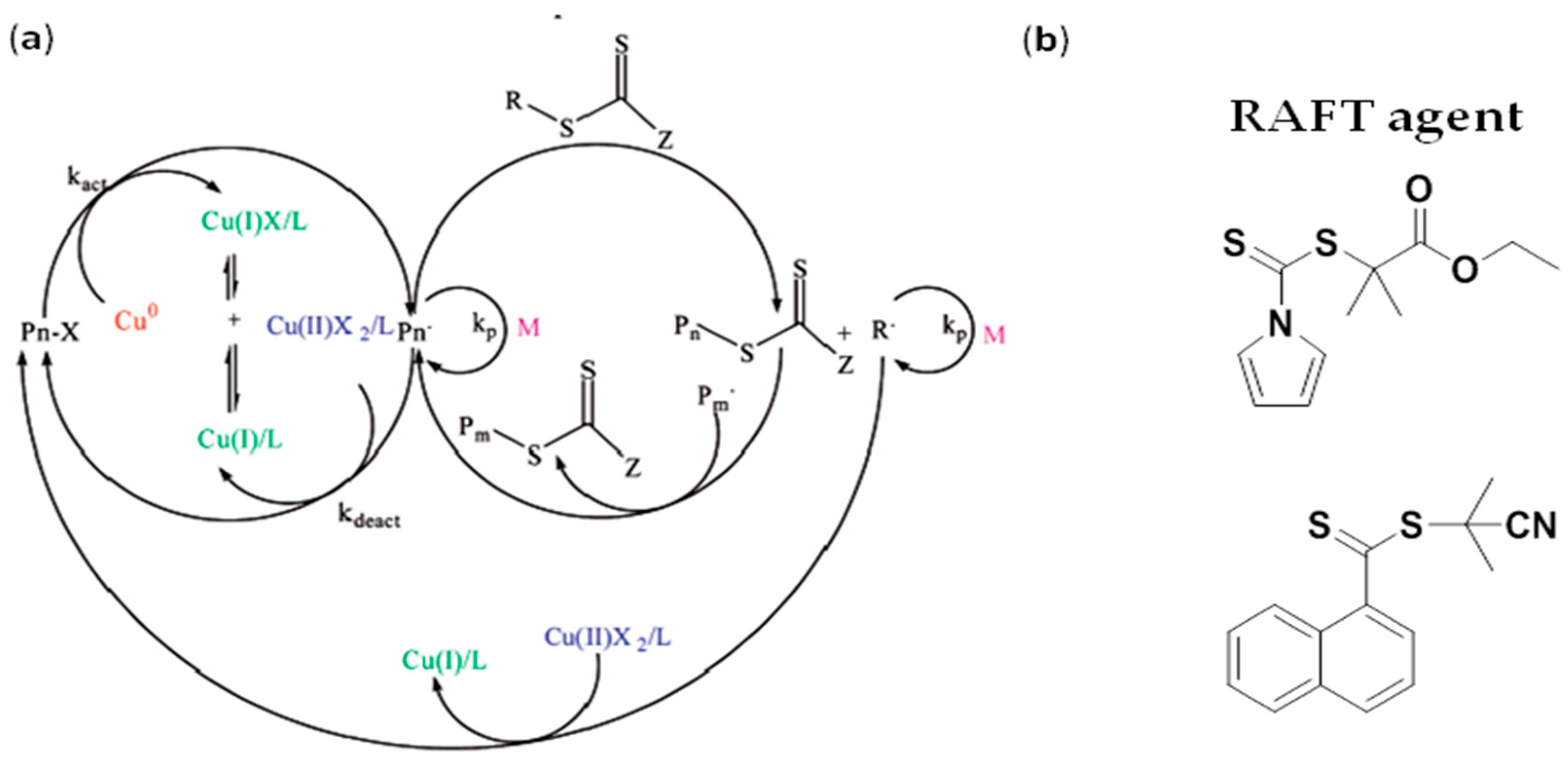



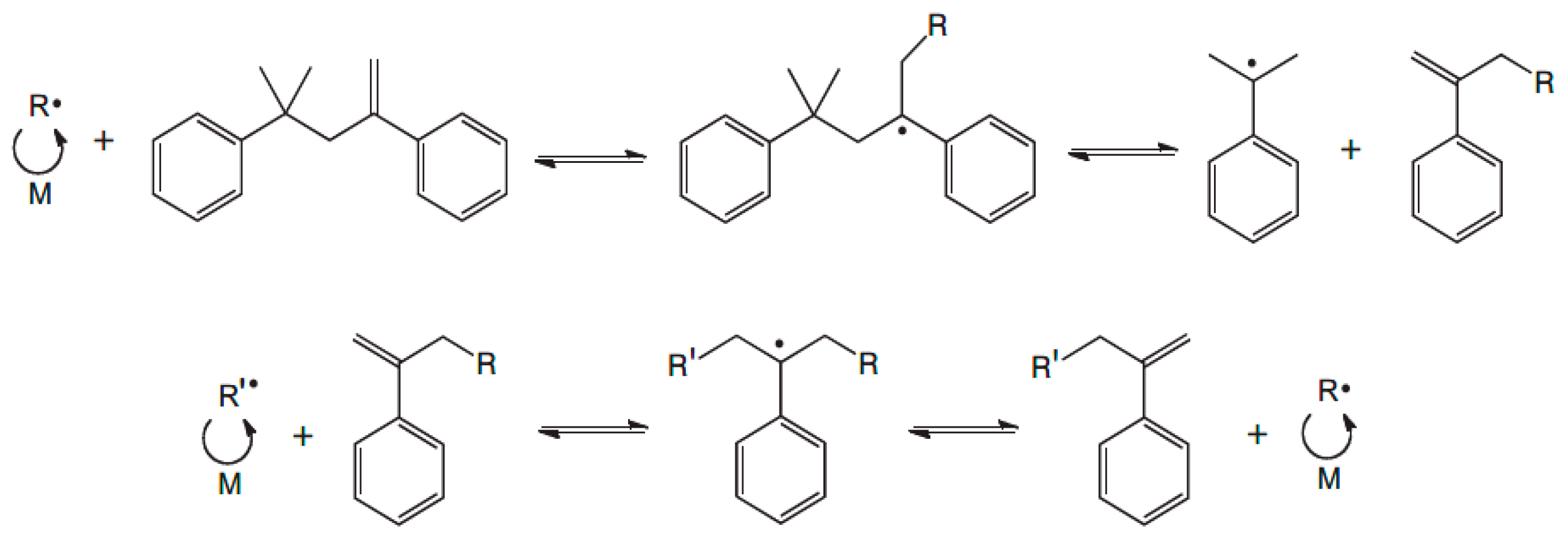


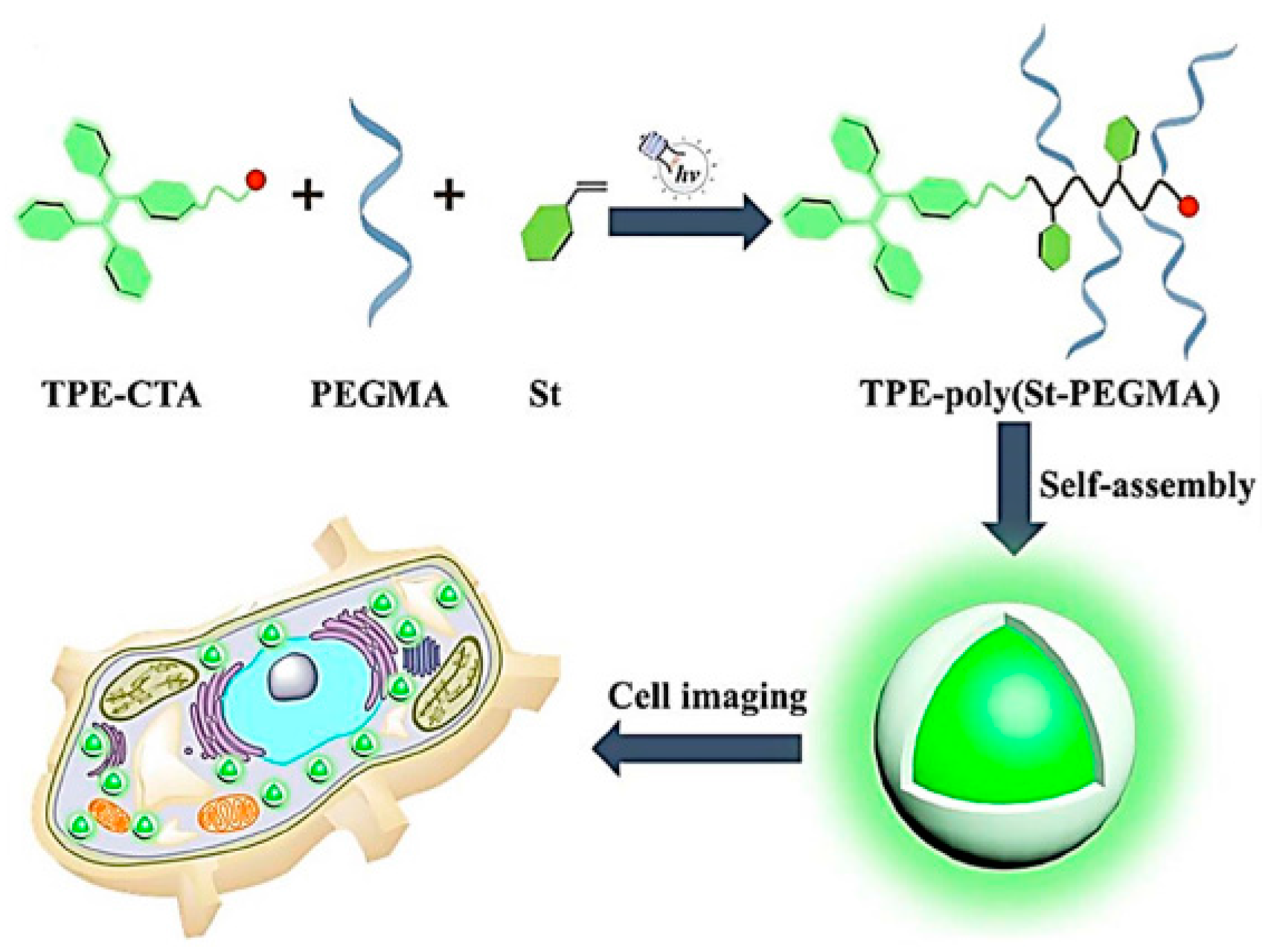
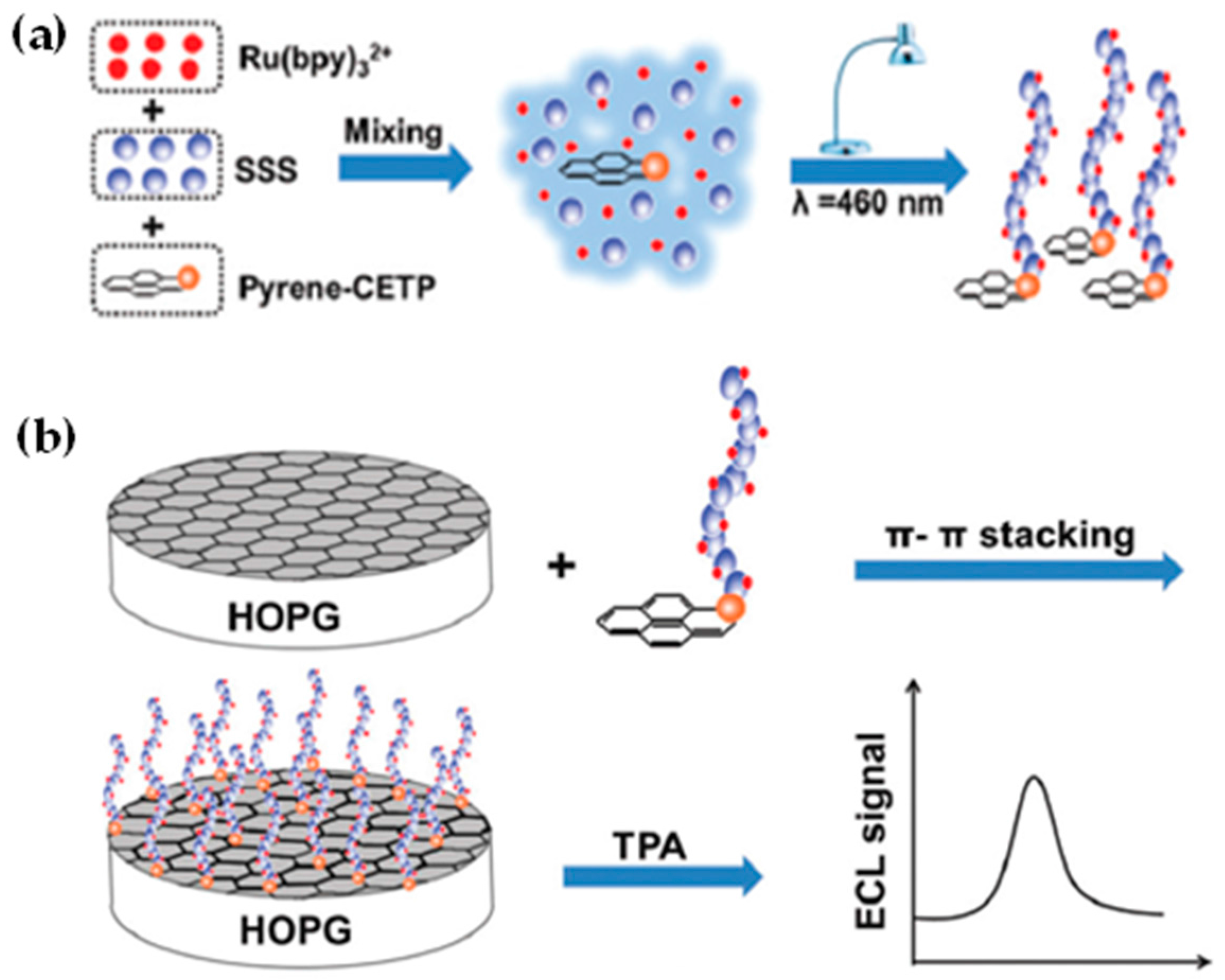
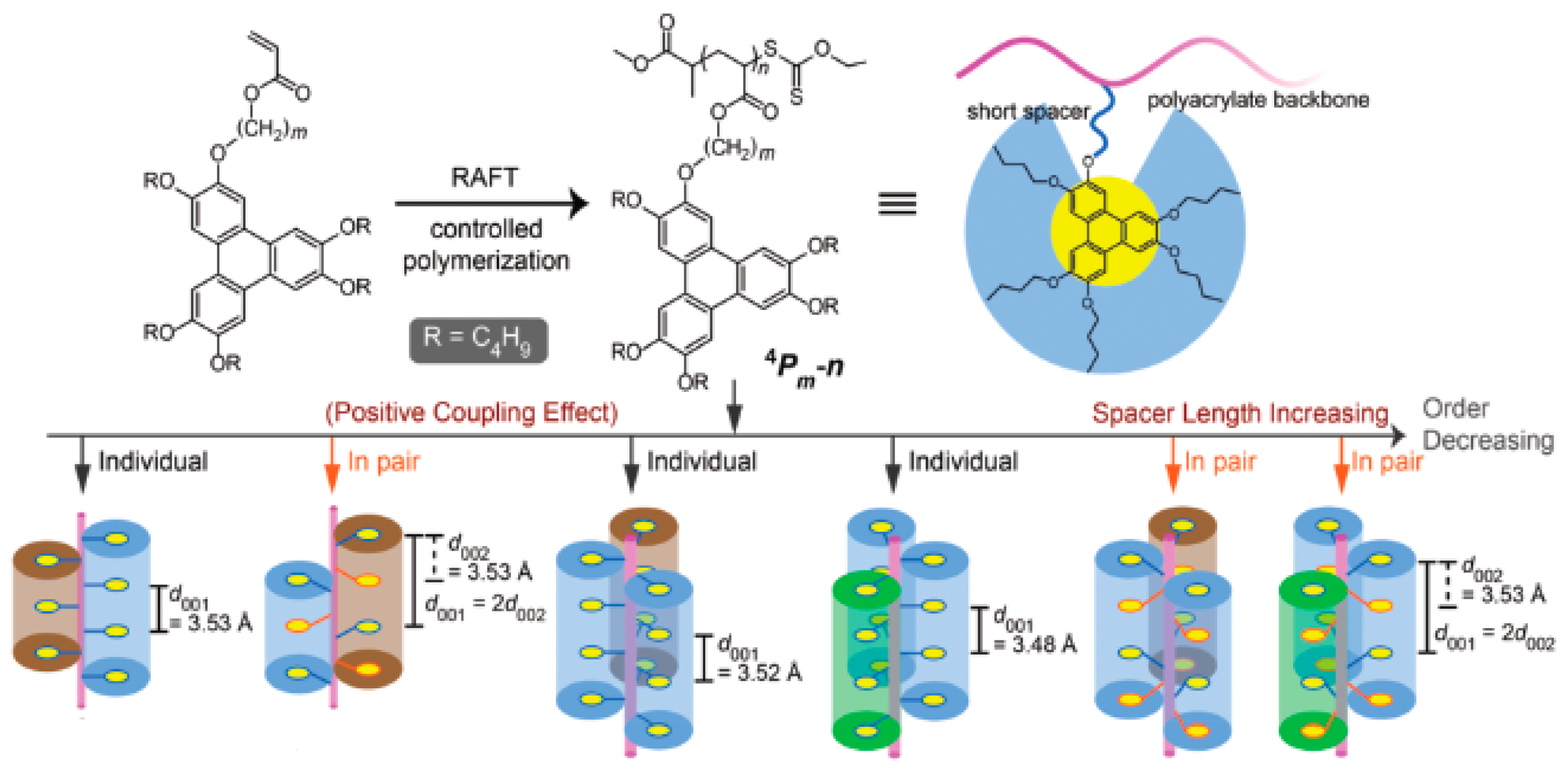
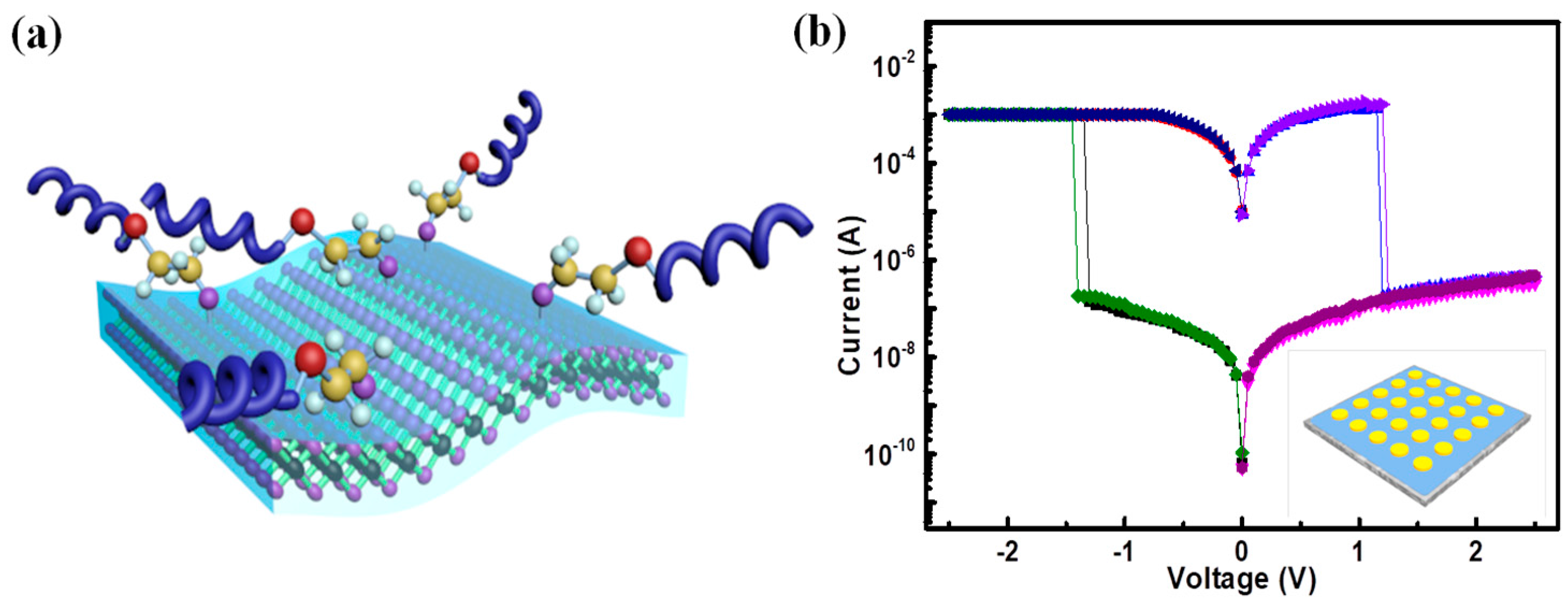
| Photoiniferter | Polymerization |
|---|---|
 | Methyl methacrylate (MMA); Methyl acrylate (MA); Styrene [47] |
 | Styrene [48] |
 | Acrylic acid (AA) [50] |
 | Vinyl acetate (VAc) [52] |
 | MA [54] |
 | Butyl methacrylate (BMA) [55,57]; MMA [57]; MA [57] |
 | MA [57] |
 | Benzyl methacrylate (BzMA) [51] |
| RAFT agent | Photoredox Catalyst | Monomer |
|---|---|---|
 |  ZnTPP [63]; Eosin Y [66]  Fluorescein [66]; Pheo A [70]; fac-[Ir(ppy)3] [58]; Ru(bpy)3Cl2 [61]; TiO2 [68]; Bacteriochlorophyll a [71] | MMA [58,63,66,68,71]; N-(2-hydroxypropyl) methacrylamide (HPMA) [58]; Oligo(ethylene glycol) methyl ether acrylate (OEGA) [61]; Oligo(ethyleneglycol) methyl ether methacrylate (OEGMA) [61]; Hydroxylethyl methacrylate (HEMA) [66]; N,N-dimethyl aminoethyl methactylate (DMAEMA) [66]; Pentafluorophenyl methacrylate (PFDMA) [66]; Methacrylic acid (MAA) [66]; Hydroxylpropyl methacrylamide (HPMA) [66]; Glycidyl methacrylate (GMA) [66]; Oligo-ethylene glycol methyl ether methacrylate (OEGMA) [66]; O-nitrobenzyl methacrylate(NBMA) [70] |
 | fac-[Ir(ppy)3] [58]; Ru(bpy)3Cl2 [61];  ZnTPP [63]; Eosin Y [67] | MA [58,63]; Styrene [58,63]; Oligo(ethyleneglycol) methyl ether acrylate (OEGA) [58,61]; Tert-butyl acrylate (tBA) [58]; N-isopropylacrylamide (NIPAAM) [58,61,63]; Isoprene [58]; N,N-dimethyl acrylamide (DMA) [58,61,63]; N,N’-diethylacrylamide (DEA) [61]; 2-(dimethylamino)ethyl acrylate (DMAEA) [63]; Polyethylene glycol (PEG)-based acrylamides [67] |
 |  ZnTPP [63,70,72] | MMA [63]; N-(2-hydroxylpropyl) methacrylamide (HPMA) [63]; O-nitrobenzyl methacrylate (NBMA) [70]; 2-(methylthio) ethyl methacrylate; (MTEMA) [72] |
 |  ZnTPP [63] | MMA [63] |
 |  ZnTPP [63]; fac-[Ir(ppy)3] [58] | Styrene [63]; MA [58] |
 | 10-phenylphenothiazine (PTH) [59] | NIPAAM [59]; DMA [59]; tBA [59]; Ethylene glycol methyl ether acrylate (EGMEA) [59] |
 | fac-[Ir(ppy)3] [58] | VAc [58]; Vinyl pivalate (VP) [58]; Dimethyl vinylphosphonate (DVP) [58]; N-vinyl pyrolidinone (NVP) [58] |
 |  TEA [65]; PMDETA [65];  g-C3N4 [73]; Me6TREN [65] | MMA [65]; BuMA [65]; Ethyl methacrylate (EMA) [65]; MA [73]; DMA [73] |
 |  TEA [65]; PMDETA [65]  g-C3N4 [73]; Me6TREN [65] | MA [65]; Styrene [65]; NIPAAM [65]; MA [73]; DMA [73] |
 |  TEA [65]; PMDETA [65];  Me6TREN [65] | OEGMA [65] |
 |  Eosin Y [69] | DMA [69]; 2-hydroxyethyl acrylate (HEA) [69]; Acid functional 2-acrylamido-2-methyl-1-propane-sulfonic acid (AMPS) [69] NIPAAM [69]; Sodium styrenesulfonate (NaSS) [69]; Poly(ethylene glycol) acrylate (PEGA) [69] |
 | g-C3N4 [73] | MA [73]; DMA [73] |
 | g-C3N4 [73] | MMA [73] |
R:  | Sodium phenyl-2,4,6-trimethyl-benzoylphosphinate (SPTP) [74] | HPMA [74] |
| RAFT Agent | Redox Initiator | Monomer |
|---|---|---|
 | BPO/DMA [83,88] | 4-azidophenyl methacrylate (APM) [83]; MA [83,88]; MMA [83,88]; Styrene [83,88] |
 | BPO/DMA [83,88]; BPO/ATP-ATA [84] | 4-azidophenyl methacrylate (APM) [83]; MA [83,88]; MMA [83,84,88]; Styrene [83,88] |
 | KPS/NaAs [85] | 2-methoxyethyl acrylate (MEA) [85]; Poly(ethylene glycol) methyl ether methacrylate (PEGDA) [85] |
 | Tert-butyl hydroperoxide (TBHP)/ascorbic acid (AsAc) [86]; TBHP/Bruggolite® FF7 (Brug 7) [86] | 4-acryloylmorpholine; HEA; DEA; EGMEA; AA; MA; NIPAAM; PEGA; DMA; 2-carboxyethylacrylate (CEA) [86] |
 | K2S2O8/Na2S2O3 [87]; H2O2/Fe2+ [90] | NIPAAM [87]; AM [87]; DMA [90]; NAM [90]; HEA [90] |
 | APS/SFS [89] | AA [89]; AM [89] |
| RAFT Agent | Initiator | Monomer |
|---|---|---|
 | Na2S2O4 [106]; ultrasonic irradiation [107]; electronreduction of BPO or BrPhN2+ [109] | Styrene [106]; MA [106,107,109]; MMA [109]; BA [109] |
 | Na2S2O4 [106]; electronreduction of BPO or BrPhN2+ [109] | MMA [106]; GMA [106]; 2-(diisopropylamino) ethyl methacrylate (DPA) [106]; DMAEMA [106]; MMA [109]; BA [109] |
 | ultrasonic irradiation [108] | HEA; OEGA; DMA; N-acryloylmorpholine (NAM); OEGMA [108] |
© 2018 by the authors. Licensee MDPI, Basel, Switzerland. This article is an open access article distributed under the terms and conditions of the Creative Commons Attribution (CC BY) license (http://creativecommons.org/licenses/by/4.0/).
Share and Cite
Tian, X.; Ding, J.; Zhang, B.; Qiu, F.; Zhuang, X.; Chen, Y. Recent Advances in RAFT Polymerization: Novel Initiation Mechanisms and Optoelectronic Applications. Polymers 2018, 10, 318. https://doi.org/10.3390/polym10030318
Tian X, Ding J, Zhang B, Qiu F, Zhuang X, Chen Y. Recent Advances in RAFT Polymerization: Novel Initiation Mechanisms and Optoelectronic Applications. Polymers. 2018; 10(3):318. https://doi.org/10.3390/polym10030318
Chicago/Turabian StyleTian, Xiangyu, Junjie Ding, Bin Zhang, Feng Qiu, Xiaodong Zhuang, and Yu Chen. 2018. "Recent Advances in RAFT Polymerization: Novel Initiation Mechanisms and Optoelectronic Applications" Polymers 10, no. 3: 318. https://doi.org/10.3390/polym10030318
APA StyleTian, X., Ding, J., Zhang, B., Qiu, F., Zhuang, X., & Chen, Y. (2018). Recent Advances in RAFT Polymerization: Novel Initiation Mechanisms and Optoelectronic Applications. Polymers, 10(3), 318. https://doi.org/10.3390/polym10030318







